![]()
![]()
![]()
Use LEFT and RIGHT arrow keys to navigate between flashcards;
Use UP and DOWN arrow keys to flip the card;
H to show hint;
A reads text to speech;
44 Cards in this Set
- Front
- Back
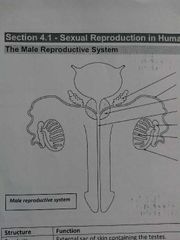
Label this diagram |
Seminal Vesicle Vas deferens Prostate Gland Urethra Epididymis Seminiferous tubules Testis |
|
|
Function of Scrotum |
External sac of skin containing the testes |
|
|
Function of Testes |
- Produce gametes - Produce testosterone (interstitial cells) - Contains a thousand copied tubules called seminiferous tubules |
|
|
Function of Epididymis |
- Storage of sperm - Sperm mature here to become mobile |
|
|
Function of Vas deferens |
Carries sperm towards the penis during ejaculation |
|
|
Function of Seminal Vesicle |
- Secretes mucus into the vas deferens - Mixture of chemicals and 60% semen - Provides nutrients - fructose, main energy source and amino acids - Alkaline - helps neutralise acidity of any urine in the urethra and acidity of the vaginal tract |
|
|
Function of Prostate Gland |
- Secretion of chemicals and 30% semen - Provides nutrients - zinc ions - Alkaline - helps neutralise acidity of any urine in the urethra and acidity of the vaginal tract |
|
|
Function of Urethra |
- Carries semen through the penis and out of the body - Carries urine from the bladder through the penis and out of the body |
|
|
Function of Penis |
- Specialised organ adapted to transfer semen to the vagina during sexual intercourse |
|
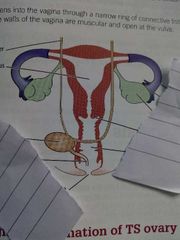
Label this diagram |
Ureter Uterus Oviduct Oviduct funnel Ovary Cervix Bladder Vagina Urethra Vulva |
|
|
Function of Ovaries |
- Production of gametes - Produce oestrogen and progesterone - Site of oocyte development |
|
|
Function of Fallopian Tubes |
They have lining of ciliated epithelial cells which move the secondary oocyte to the uterus |
|
|
Function of Uterus |
- Muscular/Elastic organ that can accommodate the developing embryo until birth - It has three layers to its wall 1. Perimetrium - thin layer around outside 2. Myometrium - Muscle layer 3. Endometrium |
|
|
Function of Endometrium |
-Mucous membrane - Well supplied with blood - Builds up every month during menstrual cycle - If implantation does not occur, endometrium is shed during menstruation |
|
|
Function of Cervix |
- Narrow ring of connective tissue and muscle - Barrier between uterus and outside environment - During pregnancy, mucous plug forms to prevent entry of pathogens |
|
|
Function of Vagina |
- Muscular walls - Opens at vulva - Semen is deposited here in sexual intercourse - Foetus passes our of vagina during birth |
|
|
Define gametogenesis |
Production of gametes in sex organs |
|
|
Define Spermatogenesis |
Production of sperm in testis |
|
|
Define oogenesis |
Production of secondary oocyte in the ovaries |
|
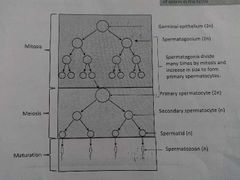
Describe what is happening here |
1. primordial germ cell = diploid, divide by mitosis to make diploid spermatogonia and more germinal epithelium cells - Multiplication Phase 2. Spermatogonia divide many times by mitosis and enlarge, produce diploid primary spermatocyte and more spermatogonia - Growth Phase 3. Primary spermatocyte undergoes meiosis I, making secondary spermatocytes which are haploid 4. Secondary spermatocytes undergo meiosis II, making haploid spermatids 5. Spermatids mature into spermatozoa or sperm (3,4,5) - Maturation Phase |
|

Label this diagram |
Germinal Epithelium Cells (2n) Spermatogonium (2n) Primary spermatocyte (2n) Secondary spermatocyte (n) Spermatids (n) Spermatozoa (n) Sertoli cell |
|
|
Function of Sertoli cells |
Provide nourishment for spermatids and protection against the male's immune system |
|
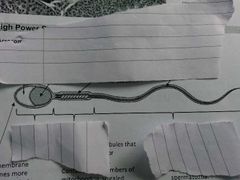
Label this diagram |
Top: Acrosome Nucleus Mitochondria Axial filament Bottom: Head Mid-section Tail |
|
|
Function of Acrosome |
Contains chemicals which dissolve the egg membrane |
|
|
Funtion mitochondria |
Site if cellular respiration and therefore release energy |
|
|
Function of midsection |
Contains microtubules that are responsible for movement of tail |
|
|
Function of tail |
Microtubules from mid-section extend into axial filament in the tail. Whiplash movement of tail propels the spermatozoa |
|
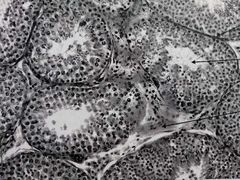
Label this image |
Basement membrane Lumen Interstitial cells |
|
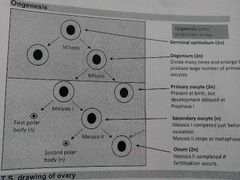
Describe what is happening here |
1. The external coat of the ovary (germinal epithelium) starts to divide to form oogonia when the female is still a foetus 2. Around 400,000 cells are at prophase of the first meiotic division when the woman is born. These are the primary oocytes 3. Each month (after puberty) one of these cells completes its first meiotic division and becomes a secondary oocyte. A polar body is also produced ( as this process takes time there are always a number of oocytes developing in the ovary at any time) 4. The secondary oocyte begins the secondary neurotic division, which will only progress past metaphase if fertilisation occurs 5. On fertilisation the division is completed to form a large ovum and a second polar body ( the first polar body may also undergo a meiotic division to form additional polar bodies) 6. Once the second meiotic division has taken place the nucleus, of the ovum fuses to that of the sperm to form a zygote |
|
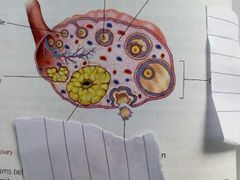
Label this diagram |
Top left and around : Primary follicle Developing secondary follicle Stroma Graafian follicle Secondary oocyte released at ovulation Corpus luteum Degenerating corpus luteum |
|

Label this diagram of a secondary oocyte |
Top left and around: Cell membrane Corona radiata - follicle cells Zona pelucida - a jelly like coat secreted by the follicle cells Cortical granules First polar body Chromosomes |
|
|
Describe the process of fertilisation |
1. Following sexual intercourse, spermatozoa move into the fallopian tubes 2. Capacitation - increases the permeability of the cello membrane in the head of the sperm above the acrosome 3. Acrosome reaction - releases hydrolase enzymes which digest the zona pellucida 4. Fusion - of sperm and secondary oocyte membranes; genetic material of sperm cell enters the secondary oocyte triggering completion of meiosis II and formation of ovum and second polar body 5. Cortical reaction - in which cortical granules fuse with the cell membrane and modify the zone pellucida to form the fertilisation membrane; this prevents polyspermy 6. Nuclei of the sperm and ovum fuses to form a zygotic nucleus |
|

Use this diagram to describe the process of implantation |
1. Cleavage The zygote undergoes repeated mitotic divisions as it moves down the oviduct to form a ball if cells called the blastocyst 2. Implantation The blastocyst moves into the uterus where it attaches and sinks into the endometrium. Cells in the outside of the blastocyst, the trophoblast cells, form the trophoblastic villi ther penetrate the endometrium. The villi increase the surface area for the absorption of nutrients from the endometrium 3. Formation of the placenta The placenta begins to develop from the trophoblast cells |
|
|
What are the 3 main roles of the placenta? |
1. Exchange of gases and nutrients Nutrients Waste products Oxygen and carbon dioxide ood 2. Providing barrier between maternal and foetal bloodProtects foetal capillaries from higher blood pressure and changes in blood pressure of the mother 3. Secretion of hormones The placenta acts as an endocrine glands: -Following implantation the placenta takes over secretions of human chorionic gonadotropin from the blastocyst. This maintains the corpus luteum and it's secretion of progesterone and oestrogen for the first 16 weeks of pregnancy -As the placenta develops it take diver secretion if progesterone and oestrogen from the corpus luteum |
|
|
Function of amniotic fluid |
Acts as a shock absorber thus protecting the foetus from injury during development |
|
|
Function of chorionic villi |
They are adapted for increased efficiency of exchange due to: -microvilli - that increase surface area -thin walls - approximately 5um therefore distance for diffusion is shorter -counter-current flow - of blood between foetal and maternal blood that maintains the concentration gradient |
|
|
Function of umbilical arteries and veins |
Transport materials between foetus and mother |
|
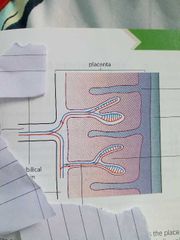
Label this diagram |
Endometrium Myometrium Lacuna Chorionic villus Chorion Umbilical vein Umbilical cord Umbilical artery |
|
|
What are the 4 hormones involved in the menstrual cycle? |
- Follcile stimulating hormone (FSH) - Luteinising hormone (LH) - Oestrogen - Progesterone |
|
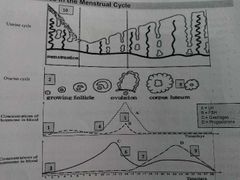
Use this diagram to describe the menstrual cycle |
1. Anterior pituitary gland secretes FSH 2. FSH stimulates maturation of primary Follcile to secondary follicle 3. Maturing Follcile secretes oestrogen 4. Oestrogen: - Stimulates LH production by anterior pituitary gland - Inhibits secretion of FSH - Triggers rebuilding if endometrium 5. LH: - Stimulates secretion of FSH - Induces ovulation on day 14 - Stimulates coversion of Graafian follicle into corpus luteum 6. FSH inhibits oestrogen production 7. Corpus luteum secretes progesterone that: - Maintains endometrium - Inhibits secretion of FSH - Inhibits secretion of LH 8. Falling levels of FSH and LH cause corpus luteum to degenerate 9. Progesterone levels decrease as secretions form degenerating corpus luteum decline 10. Low levels of progesterone and oestrogen cause endometrium to breakdown and be shed drying menstruation |
|
|
Describe the roles of hormones in pregnancy |
1. Following fertilisation (about 6 days), the developing embryo (blastocyst) begins to secrete human chorionic gonadotropin (HCG) 2. If implantation is successful, the developing placenta will take over secretions of HCG 3. The corpus luteum secretes oestrogen and progesterone 4. During pregnancy, as the corpus luteum degenerates the placenta will take over responsibility for the secretions of progesterone and oestrogen |
|
|
Why is HCG important? |
It maintains the corpus luteum for the first 16 weeks of pregnancy |
|
|
Why is it important that the corpus luteum secretes progesterone and oestrogen? |
- Inhibits FSH, preventing development of any follicle - Inhibits LH, preventing ovulation - Oestrogen: Stimulates growth of the uterus to accommodate the growing foetus Stimulates growth and development of mammary glands - Progesterone: Maintains the wall of endometrium Suppresses the uterine wall's ability to contract by inhibiting secretions of oxytocin |
|
|
Describe the role of hormones at Birth |
1. just before birth oestrogen and progesterone levels decrease 2. Oxytocin secretion by posterior pituitary gland is no longer inhibited. Secretions of oxytocin stimulates contraction of the uterine wall which stimulates more oxytocin secretion - positive feedback 3. Prolactin secreted by the anterior pituitary gland during and after broth stimulates production of milk by mammary glands |

